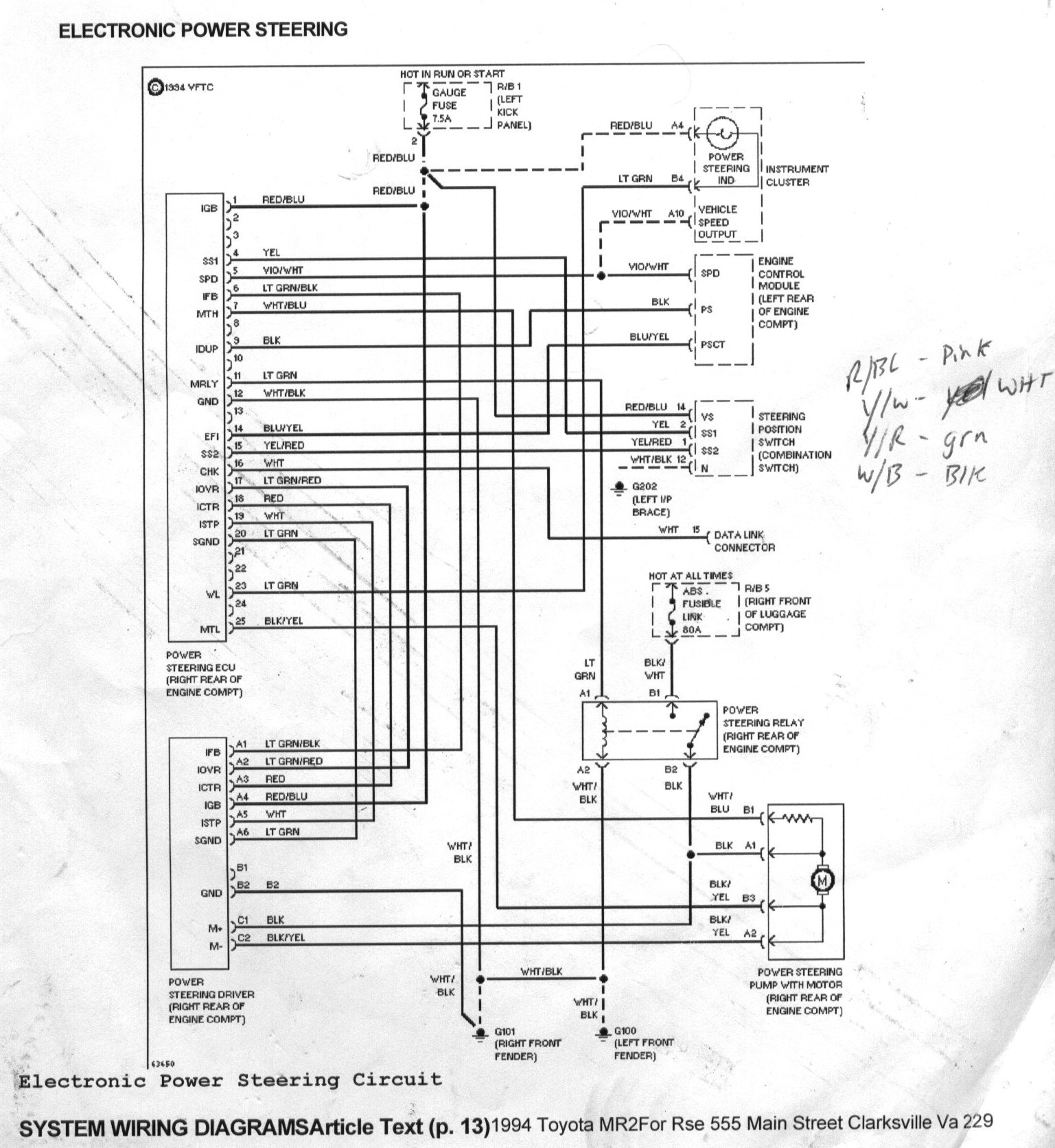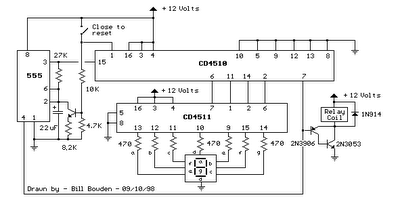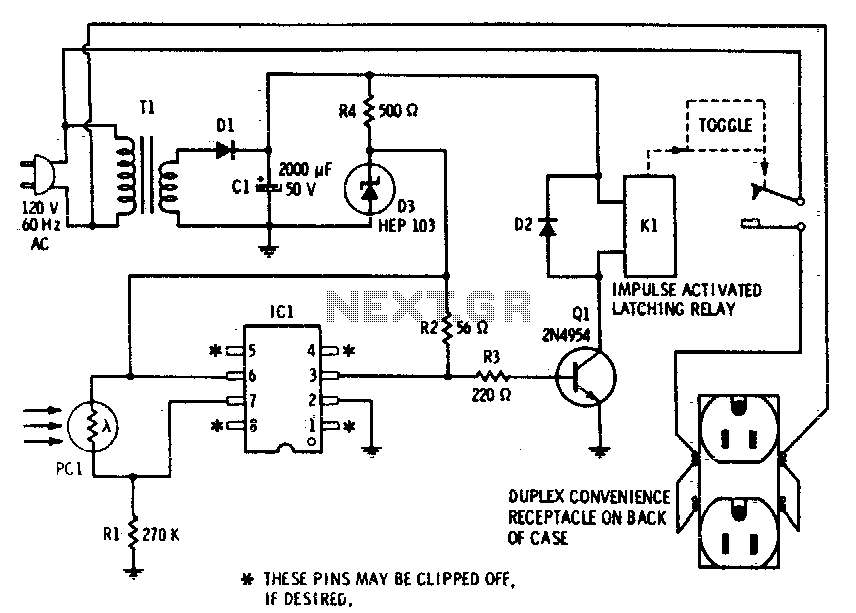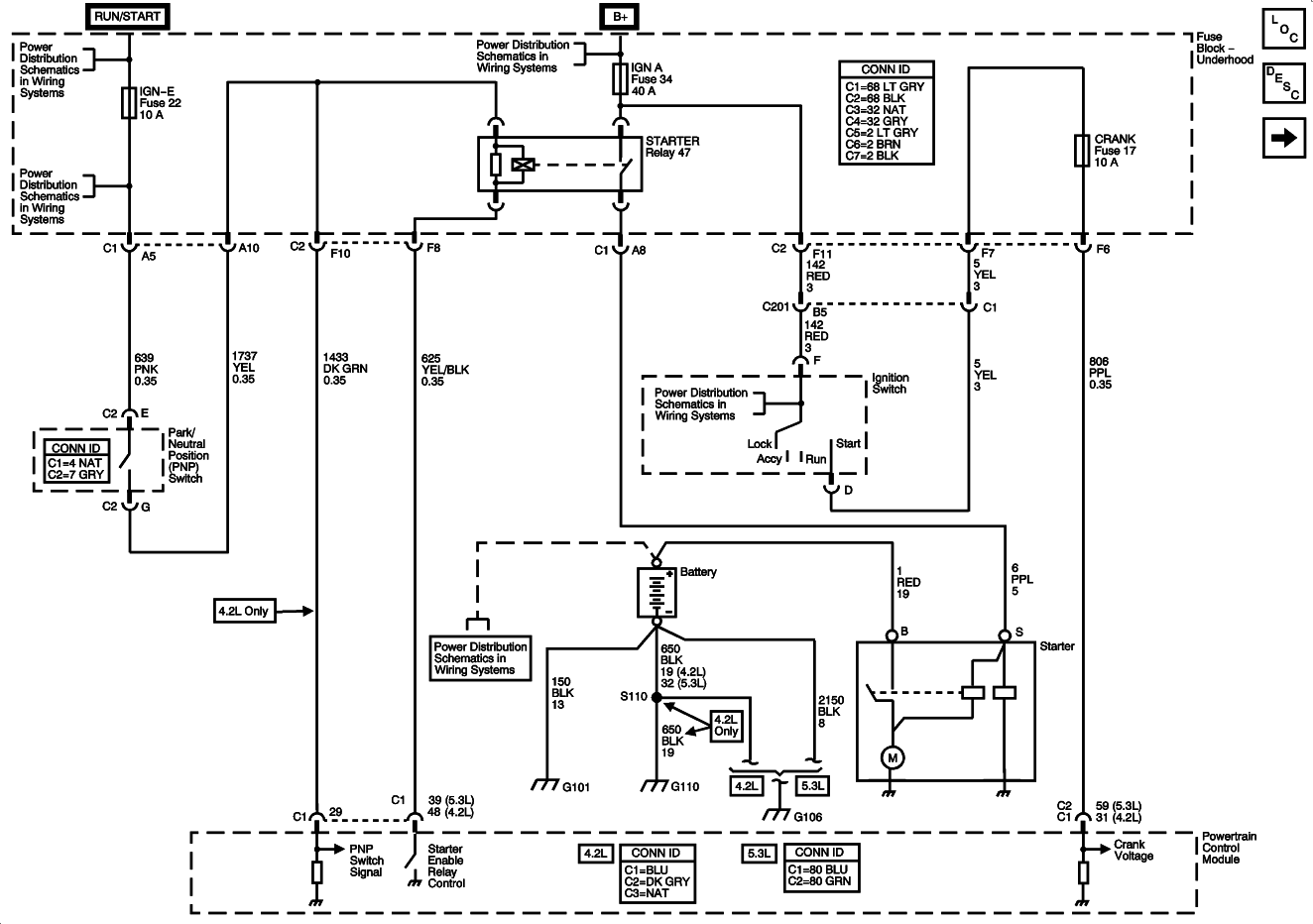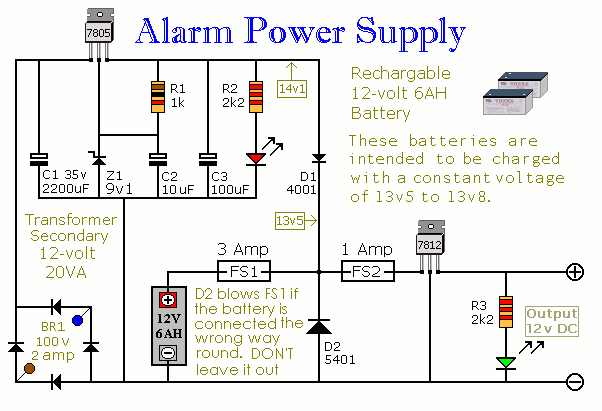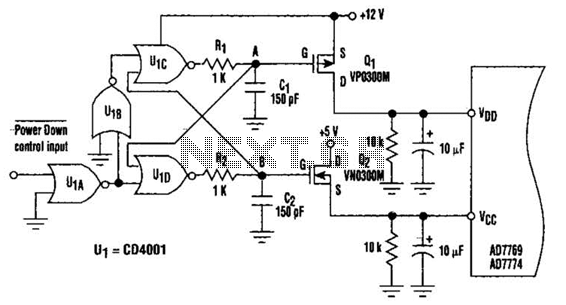
Power Supply

A switching power supply with an output voltage significantly lower than its input voltage exhibits an interesting characteristic: the current drawn by the supply is less than its output current. However, the input power (UI) is, of course, greater than the output power. It is important to monitor the input voltage during switch-on; if it is too low, the regulator may attempt to draw the full current, which can lead to failure of the supply or a blown fuse. Therefore, it is advisable to disable the regulator during switch-on (via the on/off input) until the relevant capacitor has charged. Once the regulator begins to draw current, the charging current should have decreased to a level that does not overload the voltage source. The circuit diagram provides an output voltage of 5 V powered by a 24 V source. The regulator does not need to be disabled until the capacitor is fully charged; when the potential across the capacitor reaches half or more of the input voltage, the system is safe. This is why the zener diode in the diagram is rated at 15 V. Many regulators produced by National Semiconductor feature an integral on/off switch, which is utilized in this design. The input is designed for TTL signals and typically consists of a transistor with an externally accessible base, allowing for a higher switching voltage to be applied through a series resistor, which is 22 k in this circuit. When the voltage across the capacitor reaches approximately 17 V, transistor T1 activates, enabling the regulator. The linear power supply depicted in the schematic provides 0-30 volts at a maximum of one amp, utilizing a discrete transistor regulator with op-amp feedback to regulate the output voltage. This supply was built in 1975-76 and includes a constant current mode suitable for battery recharging. In reference to the schematic, lamp LP2 serves as a power-on indicator, while the lower lamp illuminates when the unit reaches its preset current limit. Components R5, C2, and Q10 (TO-3 case) function as a capacitor multiplier. The 36-volt zener across C2 restricts the maximum supply voltage to the op-amp supply pins. D5, C4, C5, R15, and R16 provide a small negative supply for the op-amps, enabling them to function down to zero volts at the output pins (pin 6). A more modern design might eliminate these components and use a CMOS rail-to-rail op-amp. The current limit is set by components R3, D1, R4, R6, Q12, R10, and R13, which provide bias to U2, partially turning off transistors Q9 and Q11 when the current limit is reached. R4 is a front panel potentiometer for current limit adjustment, R22 adjusts the output voltage (0-30 volts), and R11 is an internal trim-pot for calibration. The meter is a one milliamp meter with an internal resistance of 40 ohms. Switch S1 determines whether the meter displays 0-30 volts or 0-1 amp. A more contemporary circuit might utilize a single IC regulator, such as the MC78XX or MC79XX series, immediately following the half-wave rectifier, to reduce the part count significantly, or employ a high-precision zener diode like the LM4040 for voltage reference due to its excellent temperature stability. IC regulators from the MC78XX series may eventually become obsolete as newer designs emerge; however, discrete transistors, op-amps, and zeners remain generic, have a longer production lifespan, and allow designers to demonstrate a fundamental understanding of linear regulated power supply operation. Building custom DC power supplies from an AC source of 110 V or 220 V is a fundamental aspect of electronics projects. Common DC voltages necessary for powering devices typically range from 3 V DC to 30 V DC, with fixed voltages such as 5V, 9V, 12V, 15V, and 18V DC being prevalent. Due to advancements in technology, many devices now utilize 1.8 V DC. Switching power supplies (SMPS) have gained popularity due to increasing demands for miniaturization and power efficiency. SMPS employs semiconductor switches (primarily MOSFETs) to switch rectified DC input at high frequencies, leading to reduced size for inductors, capacitors, and transformers. However, SMPS can introduce electrical noise, resulting in electromagnetic compatibility design challenges and increased component counts. The SMPS circuit from Power Integration uses LNK304 as its high-frequency switch. This circuit is non-isolated, meaning the output is not electrically isolated from the input; therefore, all testing should be conducted using an isolation transformer for AC line input. Hobbyists often seek a simple dual power supply for projects, as existing power supplies may be excessively large in power output or physical size. A straightforward dual power supply is essential. For most non-critical applications, the best and simplest choice for a voltage regulator is the three-terminal type. The 78xx and 79xx series can provide up to 1 A load current and include on-chip circuitry to prevent damage from overheating or excessive current, effectively shutting down rather than failing. These regulators are cost-effective, easy to use, and facilitate the design of multiple PCBs where unregulated supply is input, and regulation is performed locally on each board. This dual power supply project offers a dual output, and with the appropriate transformer and three-terminal voltage regulator pairs, it is possible to construct a compact power supply delivering up to 1 A at +/- 5V, +/- 9V, +/- 12V, +/- 15V, or +/- 18V. A center-tapped transformer and the necessary three-terminal regulator pairs, such as 7805 & 7905, 7809 & 7909, 7812 & 7912, 7815 & 7915, or 7818 & 7918, are required. It is important to note that the positive and negative regulators do not need to be matched; for instance, a +5V and -9V pair can be used. However, the positive regulator must be a 78xx series, while the negative must be a 79xx series. The project incorporates ample safety features, ensuring many years of reliable service. This dual power supply design utilizes a full-wave bridge rectifier in conjunction with a center-tapped transformer, with a transformer rated for a minimum of 7 VA or 8 watts.Switching power supply whose output voltage is appreciably lower than its input voltage has an interesting property: the current drawn by it is smaller than its output current. However, the input power (UI) is, of course, greater than the output power. There is another aspect that needs to be watched: when the input voltage at switch-on is too low , the regulator will tend to draw the full current. When the supply cannot cope with this, it fails or the fuse blows. It is, therefore, advisable to disable the regulator at switch-on (via the on/off input). until the relevant capacitor has been charged. When the regulator then starts to draw current, the charging current has already dropped to a level which does not overload the voltage source. The circuit in the diagram provides an output voltage of 5 V and is supplied by a 24 V source. The regulator need not be disabled until the capacitor is fully charged: when the potential across the capacitor has reached a level of half or more of the input voltage, all is well.
This is why the zener diode in the diagram is rated at 15 V. Many regulators produced by National Semiconductor have an integral on/off switch, and this is used in the present circuit. The input is intended for TTL signals, and usually consists of a transistor whose base is accessible externally.
This means that a higher switching voltage may be applied via a series resistor: the value of this in the present circuit is 22 k. When the voltage across the capacitor reaches a level of about 17 V, transistor T1 comes on, whereupon the regulator is enabled.
linear power supply, shown in the schematic, provides 0-30 volts, at one amp, maximum, using a discrete transistor regulator with op amp feedback to control the output voltage. The supply was constructed in 1975-6 & has a constant current mode that is used to recharge batteries.
With reference to the schematic, lamp, LP2, is a power on indicator. The other lamp (lower) lights when the unit reaches its preset current limit. R5, C2, & Q10 (TO-3 case) operate as a capacitor multiplier. The 36 volt zen-er across C2 limits the maximum supply voltage to the op amps supply pins. D5, C4, C5, R15, & R16 provide a tiny amount of negative supply for the op amps so that the op amps can operate down to zero volts at the output pins (pins 6). A more modern design might eliminate these four parts & use a CMOS rail-to-rail op-amp. Current limit is set by R3, D1, R4, R6, Q12, R10, & R13 providing a bias to U2 that partially turns off transistors Q9 & Q11 when the current limit is reached.
R4 is a front panel potentiometer that sets the current limit, R22 is a front panel potentiometer that sets the output voltage (0-30 volts), & R11 is an internal trim-pot for calibration. The meter is a one milliamp meter with an internal resistance of 40 ohms. Switch S1 determines whether the meter reads 0-30 volts, or 0-1 amp. A more new circuit might use a single IC regulator, such as the MC78XX, or MC79XX series, immediately after the half wave rectifier, to replace about 30 parts, or at least a high precision zen-er diode to replace D10 as the voltage reference.
The LM4040 is such voltage reference & has excellent stability over temperature. IC regulators such as the MC78XX series may finally become obsolete as newer IC regulators are designed, however, discrete transistors, op-amps, & zeners are more generic, have an extended production lifespan, & permit the designer to demonstrate that they understands the principles of linear regulated power supply operation. One of the basic building blocks of electronics project is building your own DC power supplies from an AC source of 110 V.
A. C or 220 V. A. C. The common DC voltages that are necessary to power up the devices are usually in the range of three V DC to 30 V DC. Usually the fixed types of DC voltages are 5V, 9V, 12V, 15V & 18V DC. With the advancement of know-how, lots of devices are using one. 8 V DC these days. S M P S is becoming common these days as the demand for miniaturization due to space constraints increases.
Take note that for linear power supply projects, you need to make use of a step down power transformer to step down the AC voltage from the line voltage of 110 V. A. C or 220 V. A. C before using it to supply to the diode bridge. In recent years, the use of switch mode power supply (SMPS) has become more comon as more applications demand for greater power eficiency.
It makes use of semiconductor (mostly MOSFET) fast switches to switch DC input that has been rectified at high frequency. The advantages of high frequency switching are that it reduces the size of inductor, capacitors & transformer used.
Other advantages of switching power supply over linear power supply are : The setback of using SMPS compared to linear power supply is that it generates electrical noise which contributes to electromagnetic compatibility design issues & more part count. The SMPS circuit below from Power Integration makes use of LNK304 as its high frequency switch. Take note that this circuit is non isolated type which means that the output is not electrically isolated from the input & all testing ought to be completed using an isolation transformer to provide the AC line input to the board.
Many times the hobbyist desires to have a simple, dual power supply for a project. Existing power supplies may be large either in power output or physical size. a simple Dual Power Supply is necessary. For most non-critical applications the best & simplest choice for a voltage regulator is the 3-terminal type. The three terminals are input, ground & output. The 78xx & 79xx series can provide up to 1A load current & it have on chip circuitry to prevent damage in the event of over heating or excessive current.
That is, the chip basically shuts down than blowing out. These regulators are cheap, simple to make use of, & they make it practical to design a method with plenty of P C Bs in which an unregulated supply is brought in & regulation is done locally on each circuit board. This Dual Power Supply project provides a dual power supply. With the appropriate choice of transformer & 3-terminal voltage regulator pairs you can basically build a tiny power supply delivering up to amp at +/- 5V, +/- 9V, +/- 12V, +/-15V or +/-18V.
You require to provide the middle tapped transformer and the 3-terminal pair of regulators you require:7805 & 7905, 7809 & 7909, 7812 & 7912, 7815 & 7915or 7818 & 7918. Note that the + & regulators do not must be matched: you can for example, use a +5v & -9V pair. However, the positive regulator must be a 78xx regulator, & the negative a 79xx. They have built in plenty of safety in to this project so it ought to give plenty of years of continuous service.
This Dual Power Supply design makes use of a full wave bridge rectifier coupled with a centre-tapped transformer. A transformer with a power output rated at at least 7VA ougwo watts. A simple calculation 🔗 External reference
This is why the zener diode in the diagram is rated at 15 V. Many regulators produced by National Semiconductor have an integral on/off switch, and this is used in the present circuit. The input is intended for TTL signals, and usually consists of a transistor whose base is accessible externally.
This means that a higher switching voltage may be applied via a series resistor: the value of this in the present circuit is 22 k. When the voltage across the capacitor reaches a level of about 17 V, transistor T1 comes on, whereupon the regulator is enabled.
linear power supply, shown in the schematic, provides 0-30 volts, at one amp, maximum, using a discrete transistor regulator with op amp feedback to control the output voltage. The supply was constructed in 1975-6 & has a constant current mode that is used to recharge batteries.
With reference to the schematic, lamp, LP2, is a power on indicator. The other lamp (lower) lights when the unit reaches its preset current limit. R5, C2, & Q10 (TO-3 case) operate as a capacitor multiplier. The 36 volt zen-er across C2 limits the maximum supply voltage to the op amps supply pins. D5, C4, C5, R15, & R16 provide a tiny amount of negative supply for the op amps so that the op amps can operate down to zero volts at the output pins (pins 6). A more modern design might eliminate these four parts & use a CMOS rail-to-rail op-amp. Current limit is set by R3, D1, R4, R6, Q12, R10, & R13 providing a bias to U2 that partially turns off transistors Q9 & Q11 when the current limit is reached.
R4 is a front panel potentiometer that sets the current limit, R22 is a front panel potentiometer that sets the output voltage (0-30 volts), & R11 is an internal trim-pot for calibration. The meter is a one milliamp meter with an internal resistance of 40 ohms. Switch S1 determines whether the meter reads 0-30 volts, or 0-1 amp. A more new circuit might use a single IC regulator, such as the MC78XX, or MC79XX series, immediately after the half wave rectifier, to replace about 30 parts, or at least a high precision zen-er diode to replace D10 as the voltage reference.
The LM4040 is such voltage reference & has excellent stability over temperature. IC regulators such as the MC78XX series may finally become obsolete as newer IC regulators are designed, however, discrete transistors, op-amps, & zeners are more generic, have an extended production lifespan, & permit the designer to demonstrate that they understands the principles of linear regulated power supply operation. One of the basic building blocks of electronics project is building your own DC power supplies from an AC source of 110 V.
A. C or 220 V. A. C. The common DC voltages that are necessary to power up the devices are usually in the range of three V DC to 30 V DC. Usually the fixed types of DC voltages are 5V, 9V, 12V, 15V & 18V DC. With the advancement of know-how, lots of devices are using one. 8 V DC these days. S M P S is becoming common these days as the demand for miniaturization due to space constraints increases.
Take note that for linear power supply projects, you need to make use of a step down power transformer to step down the AC voltage from the line voltage of 110 V. A. C or 220 V. A. C before using it to supply to the diode bridge. In recent years, the use of switch mode power supply (SMPS) has become more comon as more applications demand for greater power eficiency.
It makes use of semiconductor (mostly MOSFET) fast switches to switch DC input that has been rectified at high frequency. The advantages of high frequency switching are that it reduces the size of inductor, capacitors & transformer used.
Other advantages of switching power supply over linear power supply are : The setback of using SMPS compared to linear power supply is that it generates electrical noise which contributes to electromagnetic compatibility design issues & more part count. The SMPS circuit below from Power Integration makes use of LNK304 as its high frequency switch. Take note that this circuit is non isolated type which means that the output is not electrically isolated from the input & all testing ought to be completed using an isolation transformer to provide the AC line input to the board.
Many times the hobbyist desires to have a simple, dual power supply for a project. Existing power supplies may be large either in power output or physical size. a simple Dual Power Supply is necessary. For most non-critical applications the best & simplest choice for a voltage regulator is the 3-terminal type. The three terminals are input, ground & output. The 78xx & 79xx series can provide up to 1A load current & it have on chip circuitry to prevent damage in the event of over heating or excessive current.
That is, the chip basically shuts down than blowing out. These regulators are cheap, simple to make use of, & they make it practical to design a method with plenty of P C Bs in which an unregulated supply is brought in & regulation is done locally on each circuit board. This Dual Power Supply project provides a dual power supply. With the appropriate choice of transformer & 3-terminal voltage regulator pairs you can basically build a tiny power supply delivering up to amp at +/- 5V, +/- 9V, +/- 12V, +/-15V or +/-18V.
You require to provide the middle tapped transformer and the 3-terminal pair of regulators you require:7805 & 7905, 7809 & 7909, 7812 & 7912, 7815 & 7915or 7818 & 7918. Note that the + & regulators do not must be matched: you can for example, use a +5v & -9V pair. However, the positive regulator must be a 78xx regulator, & the negative a 79xx. They have built in plenty of safety in to this project so it ought to give plenty of years of continuous service.
This Dual Power Supply design makes use of a full wave bridge rectifier coupled with a centre-tapped transformer. A transformer with a power output rated at at least 7VA ougwo watts. A simple calculation 🔗 External reference
